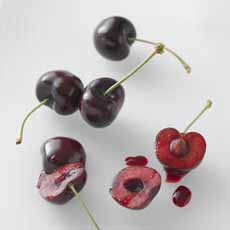TIP OF THE DAY: It’s Time To Make Turnovers
 [1] Turnovers can be any shape you can seal and crimp (photo courtesy Country Living Magazine).
|
Most people have never had a fresh cherry turnover. We make this statement categorically, because turnovers are not a commonly-found or -made food; and fresh cherries are ephemeral. Add these facts together, and the sum is that the cherry turnovers you’re likely to encounter are made with frozen cherries or cherry pie filling. So today, buck tradition and make cherry turnovers. The cherries are waiting for you in the produce section; and the cream cheese pastry pocket is so delicious, you’ll want to use this as your signature turnover recipe, with seasonal fruits. Seasonal Variations You can leave out the crystallized ginger if you’re not a ginger fan, but it’s a wow factor. RECIPE: FRESH CHERRY TURNOVERS Ingredients For 15 Turnovers For The Dough |
|
|
Preparation 1. MAKE the dough: Combine the flour, sugar, ginger and salt in the bowl of a food processor fitted with a metal blade. Pulse until well blended; then add the butter and cream cheese and pulse until the mixture resembles coarse meal. With processor running… 2. ADD the water slowly and mix just until dough comes together. Form dough into a disk, cover with plastic wrap and chill the dough for 30 minutes. 3. FORM the turnovers: In a medium bowl, mix the cherries, lemon zest, lemon juice, cornstarch and salt together. Set aside. 4. ROLL out the dough on a lightly floured surface and cut out 6-inch circles. Invert a 6″ diameter plate or bowl atop the dough and cut out with a pizza cutter or knife; if it’s a little larger or smaller, that’s fine. Gather and re-chill the dough scraps and repeat until you have 15 dough circles. 5. Evenly divide the cherry filling among the dough circles, leaving an edge to fold and crimp. Dampen the edge of each dough circle and fold in half over the cherry filling. Lightly press the edges with the tines of a fork to seal each half-moon-shaped turnover. You can also cut squares or rectangles. For a triangular shape, follow these guidelines for spanakopita, making the triangle as large as you like. 6. PLACE the turnovers on two parchment-lined baking sheets and chill for at least 30 minutes. While they chill, position the oven rack in the middle and preheat the oven to 400°F. When ready for the oven… 7. USE a sharp knife to cut 2 or 3 small vents on top of each turnover. Place the baking sheets on the middle rack of the oven and bake until the crust is golden and cherry juice begins to ooze from the vent holes, 20 to 25 minutes. Cool turnovers on a wire rack. Store in an airtight container for up to 2 days. The concept of cooking fruits and meats in pastry is thousands of years old. Given the lack of bakeware at the time—especially among the less affluent—it is easy to envision cooks of ancient eras filling squares of dough with whatever, folding the dough to seal the filling, and baking them in the fireplace. Turnovers can be sweet or savory and can be folded into half moons, rectangles, squares or triangles. Savory varieties are often used as a portable meal, as Americans grab a sandwich (think around the globe, from calzones to dosas to empanadas to spanakopita). In England, printed recipes start to appear around 1750. But given the paucity of printed cookbooks (and the literacy level of the general public), they may have been popular for centuries. Add to that a challenge: Turnovers were often called apple pies (apple being the most popular and widely available fruit filling). Sweet turnovers typically have a fruit filling and are made with a puff pastry or shortcrust pastry dough. Savory turnovers generally contain meat and/or vegetables and can be made with any sort of dough, although a kneaded yeast dough seems to be the most common in Western recipes. Turnovers are usually baked, but may be fried. Savory turnovers are often sold as convenience foods in supermarkets. Perhaps the largest number of [sweet] turnovers are sold by Kellogg’s Pop-Tarts, launched in 1965.
|
||

